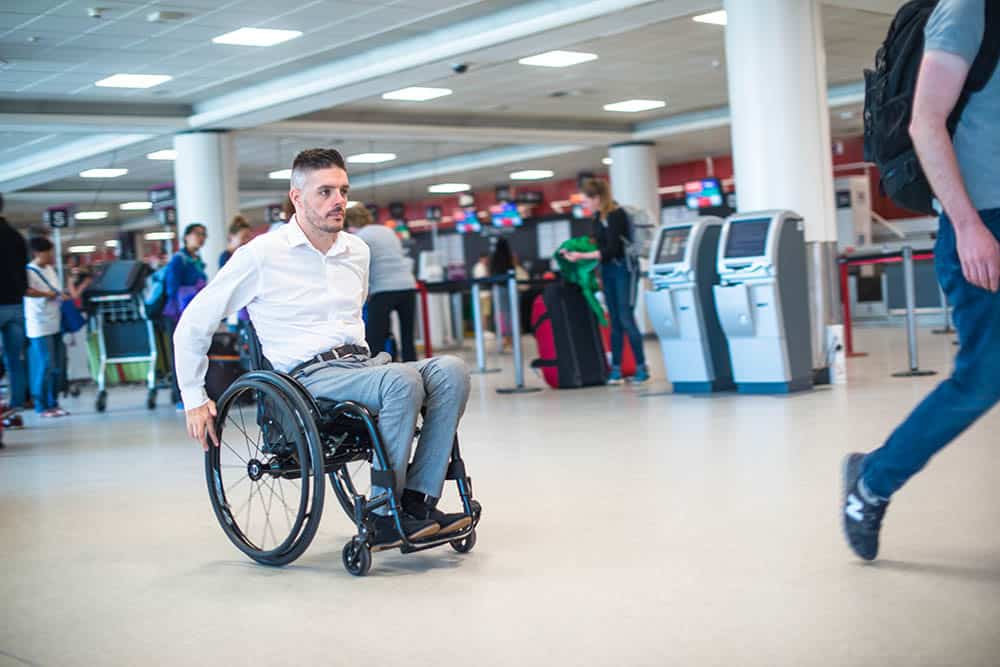First time no UK airports rank as ‘poor’ for accessibility as millions of disabled passengers take to the skies
The UK Civil Aviation Authority (CAA) has published its fourth annual report on the disability access of the UK’s largest 31 airports, as ranked by disabled passengers, revealing a broad improvement in disabled accessibility across the board.
A record number of disabled passengers
The accessibility framework aims to drive improvements in performance to improve disabled access across UK airports as air travel continues to become more popular and widespread across the disabled community.
In total, there were a record number of 3.7 million requests for assistance at UK airports between the 1st April 2018 to the 31st March 2019 – a rise of over 80 percent since 2010.
‘Very good’ airports for disabled access
Out of the 31 UK airports ranked on accessibility, 14 airports were classified as ‘very good’ over the period, achieved by airports providing high-quality support on the day of travel, alongside keeping in regular contact and consultation with its users.
Aberdeen, Belfast City, City of Derry, Cornwall Newquay, Doncaster Sheffield, Edinburgh, Exeter, Glasgow, Glasgow Prestwick, Humberside, Kirkwall, Norwich, Southampton and Sumburgh were all classified in the top tier.
Edinburgh Airport has over the past 12-months continued to invest substantially in new technology to improve the air travel experience for disabled passengers, spending £425,000 in new call points in and around the airport and partnering with digital start-up FetchyFox to launch a unique airport food and drink delivery service.
In addition, the airport purchased wheelAIR’s cooling backrest cushions from Edinburgh-based mobility dealer FastAid Products for customers in August 2018, following a successful trial.
‘Good’ airports for disabled access
16 airports were rated as ‘good’ by disabled passengers reported the CAA, with four airports that had been classified as ‘very good’ in the previous year dropping down to the ‘good’ category this year.
Belfast International, Birmingham, Bournemouth, Bristol, Cardiff, East Midlands, Inverness, Leeds Bradford, Liverpool, London City, London Gatwick, London Heathrow, London Luton, London Southend, London Stansted, Newcastle were all ranked as good.
A need for improvement
Out of all 31 airports ranked, only Manchester Airport was identified in the report as being ranked in ‘Needs Improvement’ status, which had rated ‘poor’ over the last two years.
During the year, a number of incidents involving disabled passengers were reported at the airport, including in March 2019 when 29-year-old Jessica Stafford, who has chronic fatigue syndrome, was told the special assistance service she had booked was unavailable due to staff shortages, before being asked to walk to collect her wheelchair – something her condition prevented her from doing.
In July, another passenger was forced to wait two hours before being able to exit the plane, with reports of no special assistance being available and a mix up with the traveller’s wheelchair.
According to the CAA, the Authority expects Manchester Airport to take immediate action to reverse a recent decline in performance since the end of this reporting year in time for the next accessibility reviews.
“We have received assurances from the airport that it has plans in place to address this issue and we will be closely monitoring the implementation of these plans and their impact on performance,” stated the aviation regulator.
An improving landscape for disabled passengers
For the first time since the framework’s introduction in 2016, no airports were classified as ‘poor’, whilst five airports managed to improve their ratings, suggesting disabled access for passengers is improving across much of the UK.
Despite this broad improvement, the report also highlights room for improvement, with research showing that nearly a quarter of disabled and less mobile passengers said they requested assistance because the airport environment was becoming more difficult to navigate.
In response, the CAA says it will work closely with airports to improve accessibility for disabled passengers, with this year marking the end of the report’s current criteria.
Since April this year, airports have been assessed using stricter targets, requiring airports to further improve in order to retain or improve their classifications going forward.
Paul Smith, Consumers and Markets Director at the UK Civil Aviation Authority, said: “These results show significant improvements to the experience many disabled passengers faced before our reporting began. We hope this will help passengers to feel confident and empowered to travel from UK airports.
“While it is good to see the general improvements, airports will need to continue to work hard to improve, so that they are able to meet the more demanding performance standards that we have now introduced. Where we see examples of bad practice, we will not hesitate to hold airports to account and take the necessary action.”
https://thiis.co.uk/no-uk-airports-rank-as-poor-for-accessibility-for-the-first-time-as-millions-of-disabled-passengers-take-to-the-skies/https://thiis.co.uk/wp-content/uploads/2018/11/wheelAIR-2-2.jpghttps://thiis.co.uk/wp-content/uploads/2018/11/wheelAIR-2-2-150x150.jpgNewsroomReports & ResearchAccessibility,airport,CAA,Civil Aviation Authority,disabled passengers,Edinburgh,good airports,Manchester,poor airports,PRM,very good airports,wheelAIRThe UK Civil Aviation Authority (CAA) has published its fourth annual report on the disability access of the UK’s largest 31 airports, as ranked by disabled passengers, revealing a broad improvement in disabled accessibility across the board. A record number of disabled passengers The accessibility framework aims to drive improvements in...Calvin BarnettCalvin Barnettcalvin.barnett@bhta.comAuthorTHIIS Magazine



